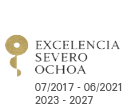Activity Detail
Seminar
Glycofullerenes for Emergent Viruses
Nazario Martin
 The supramolecular interaction carbohydrate-protein is ubiquitous in a large variety of biological processes. In order to design multivalent peripheral ligands with glycomimetic properties that structurally can attach to the receptor sites of complex biological structures, a broad variety of ‘‘artificial glycoforms’’ have been created with the aim of understanding the mechanisms involved in multivalent binding interactions.
There are many examples where multivalency drastically enhances the interactions between biomolecules in comparison to the analogous monovalent binding. In this regard, we have recently shown that hexakis-adducts of [60]fullerene endowed with 12, 24 or 36 mannoses, act as strong inhibitors for DC-SIGN in an Ebola infection assay model.1 Furthermore, a drastic increase in the inhibition process at the subnanomolar scale has been observed when the size and mannoses´ number are increased in the firstly reported tridecafullerenes endowed with 120 mannose units decorating the periphery of the molecule.2
From the work carried out by our group on glycofullerenes with globular symmetry, it is possible to bring to light the significance of size and shape of the glycomimetic, being even more determinant that the number of carbohydrate moieties in the glycoparticle. Furthermore, the synthetic approach is simplified, using C60 mono-adducts instead of C60 hexakis-adducts, without compromising the spherical form of the final glycomimetic, provided by the supramolecular aggregate resulting from the self-assembly of mono-adducts.3 The efficiency to block DC-SIGN mediated viral infection by an artificial Ebola virus has been tested in a cellular experimental assay finding that, these systems are potent inhibitors of viral infection.
In this presentation, a variety of carbon nanostructures endowed with sugars (sugar-balls) will show their effect for inhibiting infection by emergent viruses, namely Ebola, Zika and Dengue4 and, by modifying organic addend molecules, to other viruses like VIH.5
References
1. a) B. M. Illescas, J. Rojo, R. Delgado, N. Martín, "Multivalent Glycosylated Nanostructures To Inhibit Ebola Virus Infection" J. Am. Chem. Soc., 2017, 139, 6018−6025;
2. A. Muñoz, D. Sigwalt, B. M. Illescas, J. Luczkowiak, L. Rodríguez, I. Nierengarten, M. Holler, J.-S. Remy, K. Buffet, S. P. Vincent, J. Rojo, R. Delgado, J.-F. Nierengarten, N. Martín, Nature Chem., 2016, 8, 50-57.
3. A. Muñoz, B. M. Illescas, J. Luczkowiak, F. Lasala, R. Ribeiro-Viana, J. Rojo, R. Delgado, N. Martín, J. Mater. Chem. B, 2017, 5, 6566-6571.
4. a) J. Ramos-Soriano, J. J. Reina, B. M. Illescas, N. de la Cruz, L. Rodríguez-Pérez, F. Lasala, J. Rojo, R. Delgado, N. Martín, “Synthesis of Highly Efficient Multivalent Disaccharide/[60]Fullerene Nanoballs for Emergent Viruses”, J. Am. Chem. Soc., 2019, 141, 15403−15412; b) L. Rodríguez-Perez, J. Ramos-Soriano, A. Perez-Sánchez, B. M. Illescas, A. MunÞoz, J. Luczkowiak, F. Lasala, J. Rojo, R. Delgado, N. Martín, “Nanocarbon-Based Glycoconjugates as Multivalent Inhibitors of Ebola Virus Infection”, J. Am. Chem. Soc., 2018, 140, 9891−9898.
5.M. Ruiz-Santaquiteria, B. M. Illescas, J. Neyts, R. Abdelnabi, D. Schols, A. Boonen, S. Noppen, O. Martí-Marí, A. Mills, F. Gago, A. San-Félix, M. J. Camarasa, N. Martín, “Multivalent Tryptophan- and Tyrosine-Containing [60]Fullerene Hexa-Adducts as Dual HIV and Ev71 Entry Inhibitors”, Chem. Eur. J. 2021, 27,
The supramolecular interaction carbohydrate-protein is ubiquitous in a large variety of biological processes. In order to design multivalent peripheral ligands with glycomimetic properties that structurally can attach to the receptor sites of complex biological structures, a broad variety of ‘‘artificial glycoforms’’ have been created with the aim of understanding the mechanisms involved in multivalent binding interactions.
There are many examples where multivalency drastically enhances the interactions between biomolecules in comparison to the analogous monovalent binding. In this regard, we have recently shown that hexakis-adducts of [60]fullerene endowed with 12, 24 or 36 mannoses, act as strong inhibitors for DC-SIGN in an Ebola infection assay model.1 Furthermore, a drastic increase in the inhibition process at the subnanomolar scale has been observed when the size and mannoses´ number are increased in the firstly reported tridecafullerenes endowed with 120 mannose units decorating the periphery of the molecule.2
From the work carried out by our group on glycofullerenes with globular symmetry, it is possible to bring to light the significance of size and shape of the glycomimetic, being even more determinant that the number of carbohydrate moieties in the glycoparticle. Furthermore, the synthetic approach is simplified, using C60 mono-adducts instead of C60 hexakis-adducts, without compromising the spherical form of the final glycomimetic, provided by the supramolecular aggregate resulting from the self-assembly of mono-adducts.3 The efficiency to block DC-SIGN mediated viral infection by an artificial Ebola virus has been tested in a cellular experimental assay finding that, these systems are potent inhibitors of viral infection.
In this presentation, a variety of carbon nanostructures endowed with sugars (sugar-balls) will show their effect for inhibiting infection by emergent viruses, namely Ebola, Zika and Dengue4 and, by modifying organic addend molecules, to other viruses like VIH.5
References
1. a) B. M. Illescas, J. Rojo, R. Delgado, N. Martín, "Multivalent Glycosylated Nanostructures To Inhibit Ebola Virus Infection" J. Am. Chem. Soc., 2017, 139, 6018−6025;
2. A. Muñoz, D. Sigwalt, B. M. Illescas, J. Luczkowiak, L. Rodríguez, I. Nierengarten, M. Holler, J.-S. Remy, K. Buffet, S. P. Vincent, J. Rojo, R. Delgado, J.-F. Nierengarten, N. Martín, Nature Chem., 2016, 8, 50-57.
3. A. Muñoz, B. M. Illescas, J. Luczkowiak, F. Lasala, R. Ribeiro-Viana, J. Rojo, R. Delgado, N. Martín, J. Mater. Chem. B, 2017, 5, 6566-6571.
4. a) J. Ramos-Soriano, J. J. Reina, B. M. Illescas, N. de la Cruz, L. Rodríguez-Pérez, F. Lasala, J. Rojo, R. Delgado, N. Martín, “Synthesis of Highly Efficient Multivalent Disaccharide/[60]Fullerene Nanoballs for Emergent Viruses”, J. Am. Chem. Soc., 2019, 141, 15403−15412; b) L. Rodríguez-Perez, J. Ramos-Soriano, A. Perez-Sánchez, B. M. Illescas, A. MunÞoz, J. Luczkowiak, F. Lasala, J. Rojo, R. Delgado, N. Martín, “Nanocarbon-Based Glycoconjugates as Multivalent Inhibitors of Ebola Virus Infection”, J. Am. Chem. Soc., 2018, 140, 9891−9898.
5.M. Ruiz-Santaquiteria, B. M. Illescas, J. Neyts, R. Abdelnabi, D. Schols, A. Boonen, S. Noppen, O. Martí-Marí, A. Mills, F. Gago, A. San-Félix, M. J. Camarasa, N. Martín, “Multivalent Tryptophan- and Tyrosine-Containing [60]Fullerene Hexa-Adducts as Dual HIV and Ev71 Entry Inhibitors”, Chem. Eur. J. 2021, 27,





